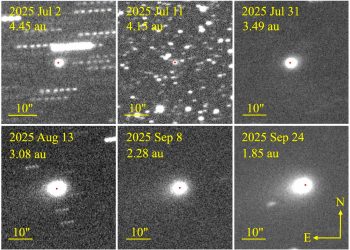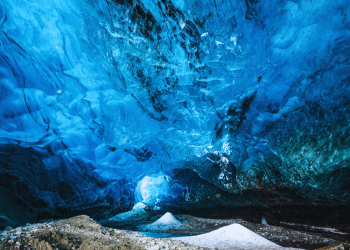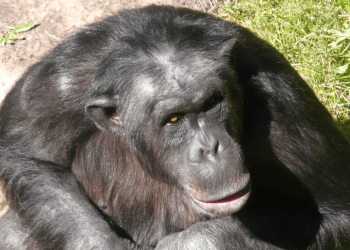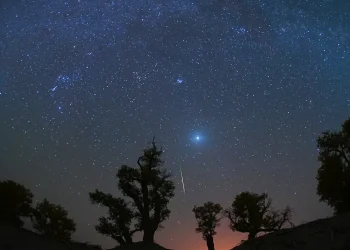Before sunrise on October 1, 2025, a tiny asteroid called “2025 TF” flew past Antarctica at an altitude near 266 miles, roughly the same orbit used by the International Space Station. The closest approach occurred at 00:47:26 UTC with an uncertainty of 18 seconds.
The rock was only about 3 to 10 feet wide, too small to pose a serious danger on the surface. It was first noticed a few hours later by the Catalina Sky Survey, then quickly confirmed from Australia, and the official report of the discovery appears in a circular from the Minor Planet Center (MBCC).
Asteroid 2025 TF above Antarctica
2025 TF, according to NASA’s Small Body database, crept across the sky while most telescopes were busy with other fields, and it did so quickly. By the time the alert systems compared the images and reported the movement, the passage was already complete.
A meter-scale asteroid doesn’t reflect much sunlight, so it remains faint until it’s very close. Its apparent movement on the detector may be a trail that standard software initially ignores as a false artifact.
Once the object was reported, the Planetary Defense Office coordinated a rapid follow-up using a telescope at the Las Cumbres Observatory in Siding Spring.
These new measurements refined the orbit, the curved path an object follows as gravity pulls it around a planet or the Sun, enough to determine the time of closest approach within a narrow window.
What counts as “near” in space
Astronomers track the center-to-center separation of the Earth and an object, a geocentric distance, which is the distance between an object and the center of the Earth rather than its surface, and then compare it to the radius of the Earth to describe the altitude above the surface.
They also cite distances in the astronomical unit, a standard equal to the average Earth-Sun distance, for consistency across the solar system.
Even a few hundred kilometers away, it is still outside the atmosphere, the layer of gas that surrounds Earth, so the asteroid never felt any drag. It crossed the vicinity of the Earth, then resumed its trajectory around the Sun.
The short observation arc meant that uncertainty remained for some time, but the additional astrometry, the precise measurement of an object’s position in the sky, reduced this spread. The final adjustment provided a timestamp and altitude with kilometer-level accuracy.
Tiny asteroids like 2025 TF escape attention
These rocks are faint until recent hours and are moving rapidly against the stars. Low cloud cover or a bright Moon can hide them, and even clear nights aren’t enough if a survey camera isn’t looking at the right part of the sky.
“Small asteroids like 2022 EB5 are plentiful,” said Paul Chodas, director of JPL’s Center for Near-Earth Object Studies (CNEOS).
He noted that very few objects are detected early because they only brighten shortly before impact or a very close pass.
“Asteroids of this size are much smaller than the ones we are tasked with tracking,” said Davide Farnocchia, a scientist at JPL’s Center for Near-Earth Object Studies. Most national programs focus on much larger organizations that could have regional or global effects.
How scientists traced its path
Each 2025 TF exposure measured position to a fraction of an arcsecond, a small unit of angular size equal to 1/3600 of a degree.
Feed these measurements into an orbit solver, a mathematical program that calculates how gravity shapes an object’s motion, and you get the trajectory shape, timing and closest distance.
The solution can be updated in near real time as new images arrive.
The official notice of discovery compiled community observations from several stations. Together, they were enough to reconstruct a clean and precise overview.
What does a pass like this mean for risk
A car-sized asteroid like 2025 TF would break up in the atmosphere if it actually fell, creating a bright bolide, a large, explosive meteor that lights up the sky and possibly scatters small meteorites.
The main danger would be acoustic and light effects because the energy is released high above the ground.
There is another type of risk to the spacecraft if the timing and trajectory intersect an orbiting satellite. Space is vast, even in low Earth orbit, and the risk of collision during an event like this is very low.
“No, fortunately there have been no known asteroid threats to Earth for at least 100 years,” said Davide Farnocchia. NASA also notes that known asteroids won’t threaten Earth for at least a century.
How the surveillance system works
Surveys such as the Catalina Sky Survey in Arizona, ATLAS in Hawaii and the Southern Hemisphere, and Pan-STARRS on Haleakalā scan the sky every clear night. Their software looks for points that move relative to the background stars.
When a moving point appears, the data is sent to the Minor Planet Center for verification and publication on the Near-Earth Object Confirmation page. NASA’s Center for Near-Earth Object Studies (CNEOS) then calculates precise orbits and updates the predictions.
ESA’s Near-Earth Object Coordination Center (NEOCC) maintains a rolling list of recent and upcoming approaches to Earth.
This service also maintains a hazard list, a ranking of objects that have a measurable chance of hitting Earth, updated daily for objects that merit further examination.
Why 2025 TF still matters
Such a close passage without warning is a reminder that small objects are numerous and difficult to see. It was also a success because follow-up observations made it possible to trace the trail with remarkable precision.
Data from tiny visitors like 2025 TF helps test warning pipelines, orbit solvers, and observer coordination. Each case makes the global network faster and more reliable.
The numbers also help refine models on how often such events occur. This results in better estimates of the fall rates of meteors and meteorites.
Survey coverage and sensitivity continue to improve as new cameras and software come online. The community’s goal is to extend early detection to smaller sizes and longer warning times.
As more of these weak items are captured, the stats will move from anecdotes to firm rates. This will help refine risk estimates and determine where to invest in the next round of instruments.
This event shows the value of everyone, from amateur observers to large installations. The transfer from discovery to tracking to on-orbit solution worked as it is supposed to work.
—–
Do you like what you read? Subscribe to our newsletter for engaging articles, exclusive content and the latest updates.
Check us out on EarthSnap, a free app brought to you by Eric Ralls and Earth.com.
—–









